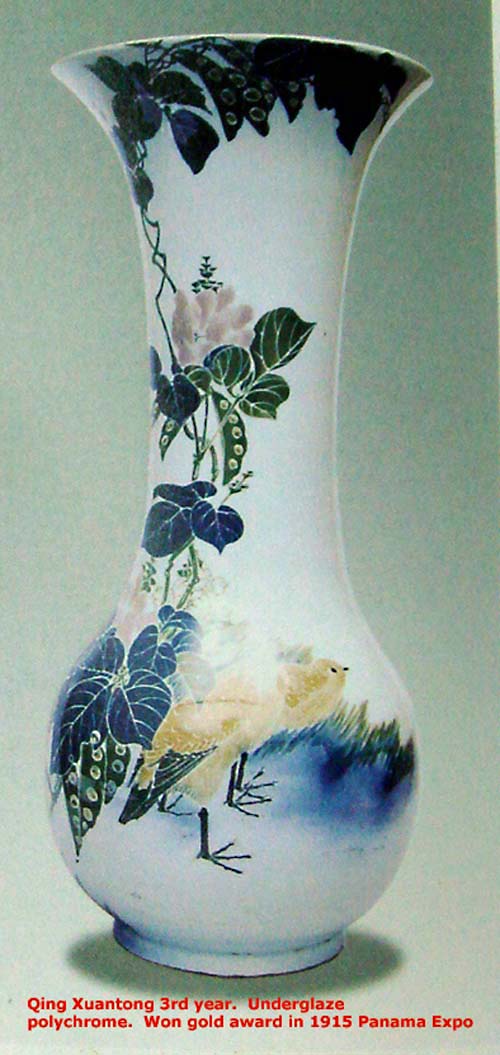 |
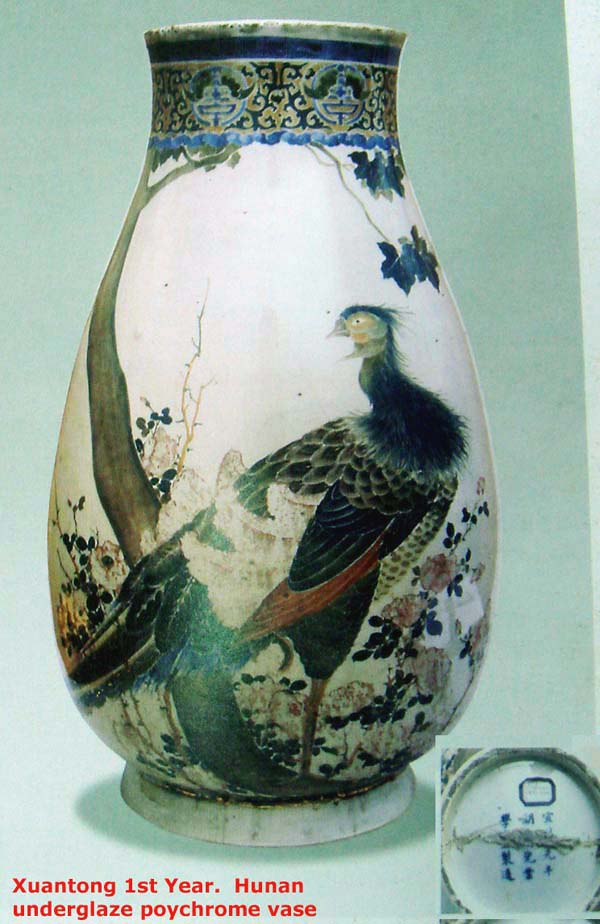 |
Republican Porcelain
Attempts at revitalisation of Porcelain industry through Porcelain companies
The late Qing period witnessed the steady decline in the Chinese porcelain industry. The Jingdezhen porcelain industry made an anaemic recovery after the turmoil caused by the Taiping rebellion. Coupled with competition from cheap Japanese porcelains in the domestic market and European porcelains and pottery wares in the export market, the Chinese porcelain industry faced an increasingly bleak prospect. Some enlightened individuals recognised the urgent need for restructuring to revitalise the porcelain industry. Among the pioneers was a Qing official Xiong Xiling (熊希龄) of Hunan province. He set up the Hunan Porcelain School in A.D 1906 which taught courses on use of the potter's wheel, making models and moulds and porcelain painting. He recruited noted Jingdezhen and Japanese craftsmen to teach the skills. The craftsmen also developed the underglaze polychrome decorations. Later Xiong was able to raise the required funds from private and government sources to set up the Hunan Porcelain Company in Liling (醴陵). It was famous for the production of Liling underglaze polychrome decorations which won a number of prizes in the Panama and Italy Exposition. The factory was destroyed during the war in A.D 1918 but was rebuilt. However production quality and quantity deteriorated and ceased production sometime after A.D 1930. The underglaze polychrome know-how was temporarily lost but during the 1950s, the old Hunan craftsmen helped to re-introduce underglaze polychrome techniques. Since then, many more colours were introduced and Liling underglaze polychrome continues to attract many admirers till this day.
 |
 |
The success of this type of product prompted potters from Guangdong Dapu Gaopi (广东大浦高坡),Shangdong Zibo (山东淄博) , Shanxi and Hebei Pengcheng (河北彭城) to produce similar wares. They can be distinguished from the Liling product by the layer of white slip over the coarse paste of the vessel. Due to the use of a slip, it has poorer adhesion and tends to flake more easily. But similar underglaze polychrome products made in Guangdong Dapu Gaopi (广东大浦高披)are more difficult to tell apart and wrongly attributed to Liling by the uninformed. There are distinguishable difference in terms of the paste of the body of the vessel, the quality and style of decoration and the relatively limited range of colours.
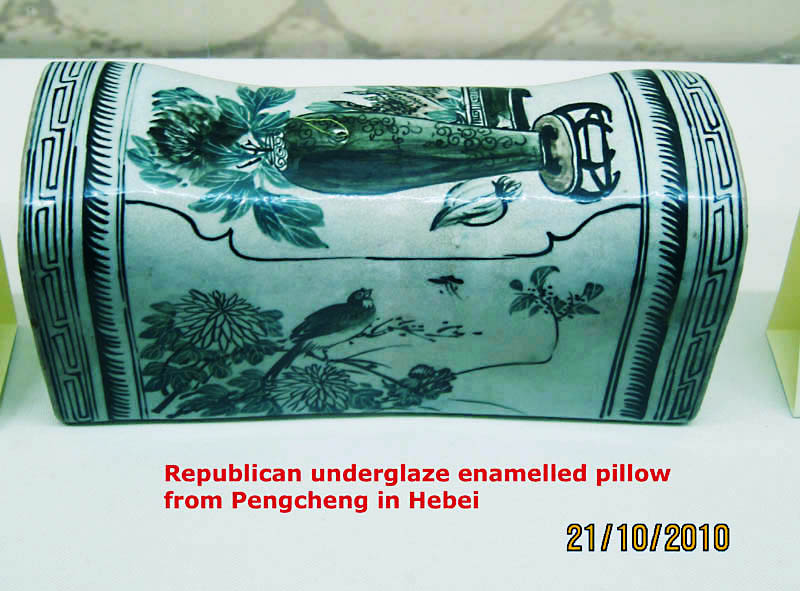
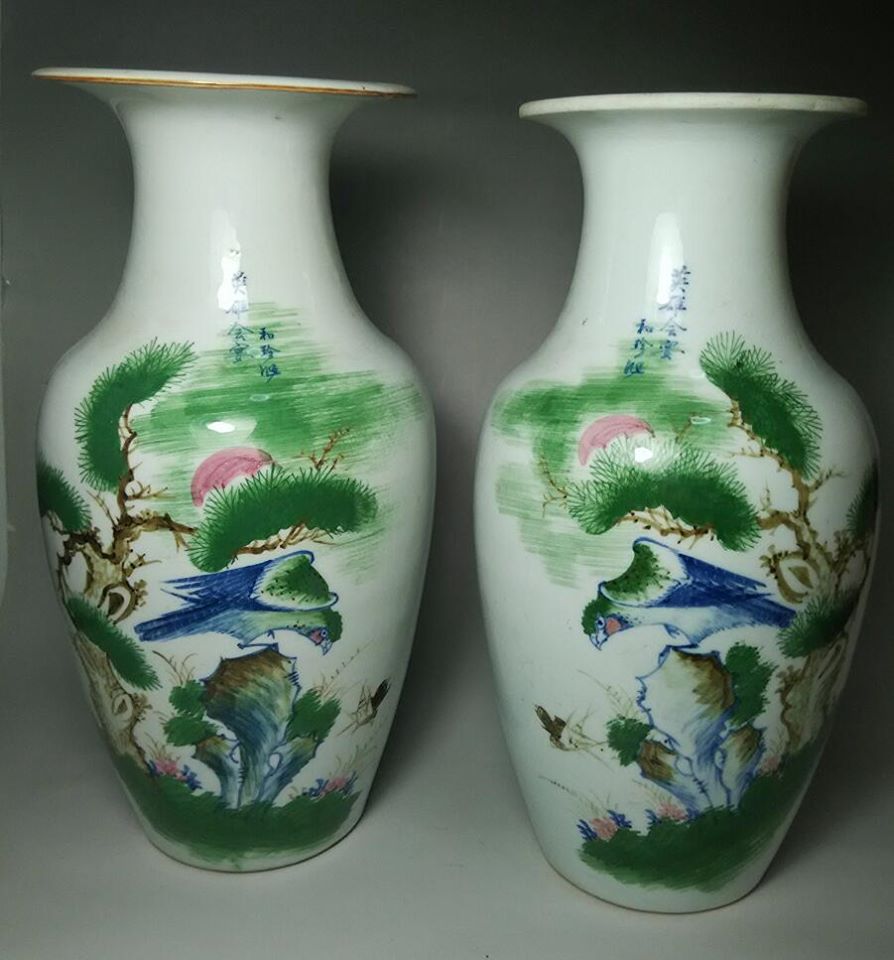
Pair of Republic Guangdong Dapu Gapi vases with underglaze polychome decoration
Chaozhou Fengxi also emerged as an important porcelain production centre. Besides blue and white and overglaze enameled ware, it also introduced a distinctive type of in-glaze polychrome decorated ware by the late 1910s. The enamels initially imported from Japan, is suitable for firing at high temperature. Subsequently, the potters from Fengxi were able to produce such enamels locally and even introduced new variants. The enamels were applied on the glazed surface of unfired porcelain wares. Upon completion of the decoration, the wares were fired in dragon kiln at temperature ranging from 1200 go 1280 degree centigrade. During firing, the glaze flowed over and covered the decoration. Hence, in essence it is a form of in-glaze decoration. A common distinctive characteristic of Chaozhou porcelain is the fine crazing of the glaze. For more on Chaozhou Fengxi ware, please read this article.

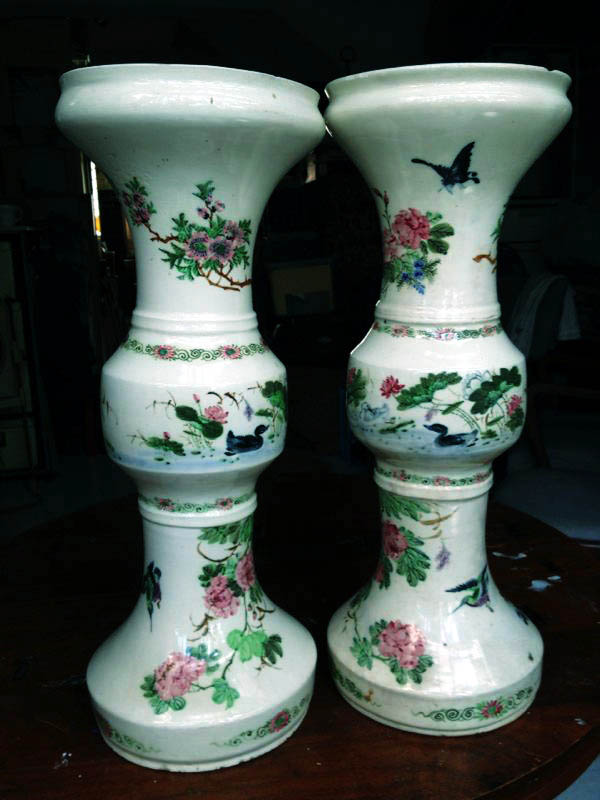
Examples of Chaozhou Fengxi in-glaze polychrome decoration
Another important company was the Jiangxi Porcelain Company which was formed in A.D 1910 with private and government capital. The company also set up a school to carry out research on mechanization of production, quality improvement and firing with coal as fuel. The products of the company were generally of good quality. Despite the cessation of government funds after the A.D 1911 revolution which overthrew the Qing Dynasty, it continued operation at least till A.D 1934. Products from the company carried the mark, "Jiangxi Ciye Gongsi "(江西瓷业公司). There were also many other porcelain companies set up in other provinces. Most of the porcelain companies were engaged in the production of utilitarian wares.

|
|
Porcelain plaque with Jiangxi Ciye Gongsi written The inscription |
Introduction of Yangcai (洋彩)
Majority
of the overglaze enamelled wares during the Republican period were done by private workshops called hongdian (红店).
Besides the traditional fencai and Qianjiang genre, a new type of imported
enamels call Yangcai (洋彩)or shuicai (水彩)was
introduced. The Chinese
classify this type of enamel as Shu Liao (熟料),i.e
the colour of the enamels has gone through complete processing, the physical
appearance is the same after firing. Fencai or Wucai is Sheng Liao (生料),the exact colour will only be revealed after
firing. From
around
1911,increasing number of
ceramic craftsmen started to use Yangcai to paint qianjiang style porcelain.
The design using yangcai can be painted directly on vessel just like water colour on paper. The pigments are synthetic materials whose
colorants include metal oxides and silicates. Range of colour available is
wide. More intermediate shades can be obtained by blending the existing
colour. The enamels are thin and colour more even and lack the sort
of tonal variation of fencai.
The most obvious way to tell Yangcai painting is through tactile method.
It is so thin that one almost cannot feel it whereas for fencai we can detect it
is slightly above the porcelain surface.
Nowadays, Yangcai is also termed Shuicai (水彩),
meaning water colour.
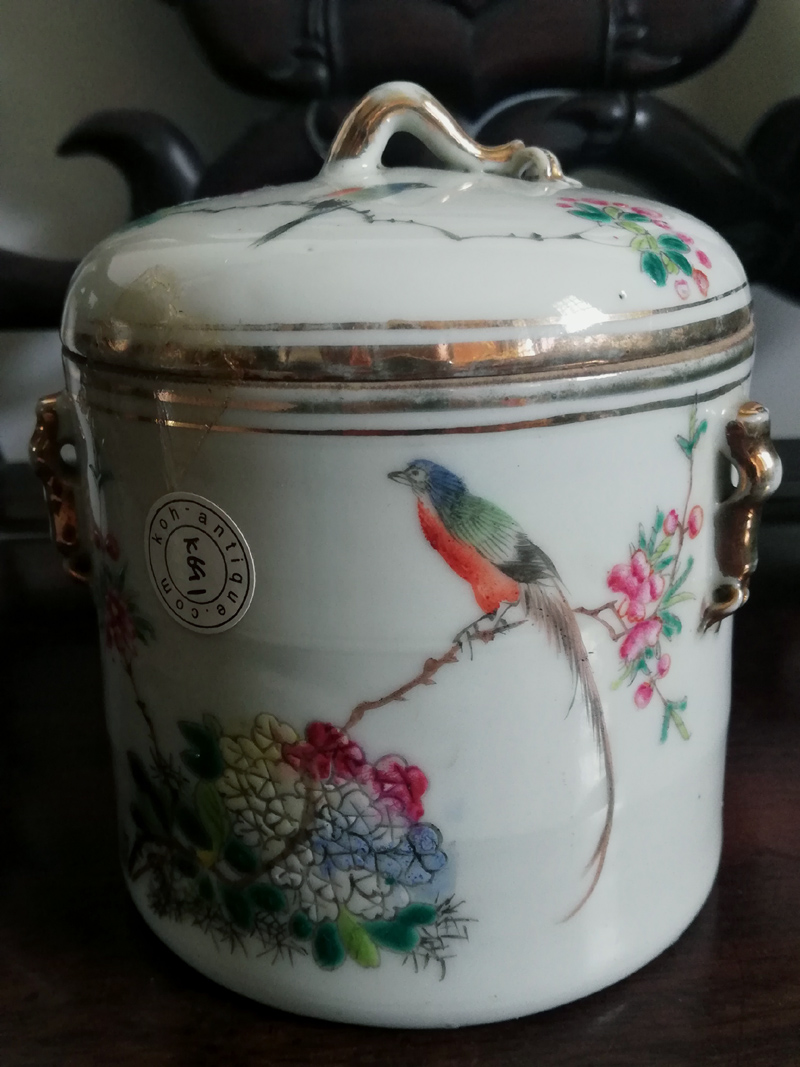 |
| An example with flower and leaves painted using fencai and bird in Yangcai |
Initially consumers were attracted by the brightly coloured decoration. But the novelty slowly worned off and it only enjoyed a short period of success. Subsequently, the shortcomings of Yangcai became apparent compared with the fencai based qianjiang decoration. Yangcai is thin and even tone. It lacks the depth and expressiveness of the fencai based enamels and it is difficult to capture the intrinsic quality of ink painting. Only a small number of skillful and accomplished artists were able to achieve some degree of success in their work.
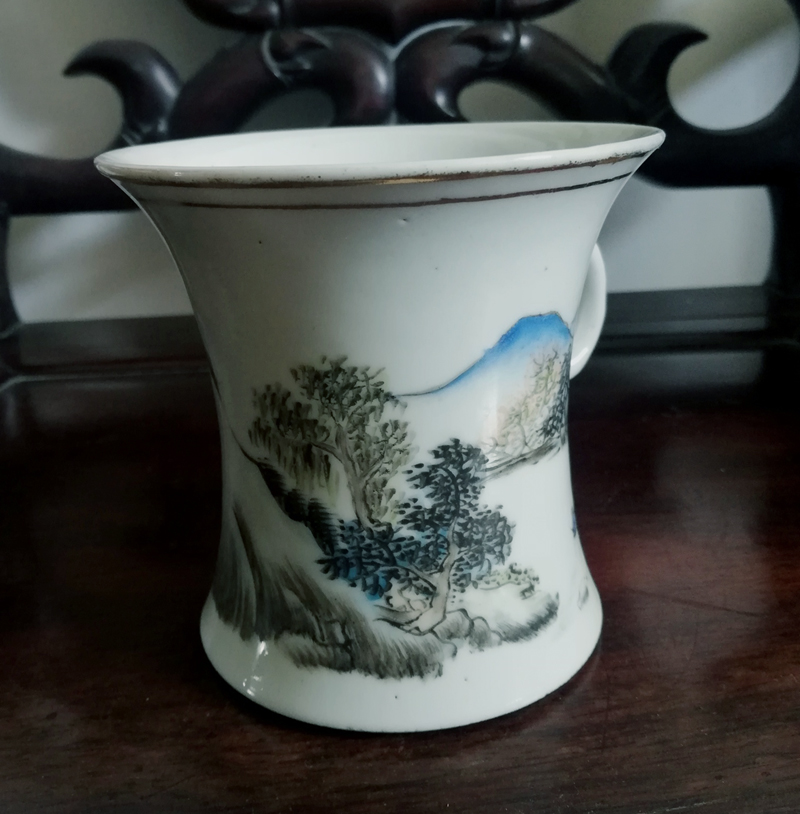 |
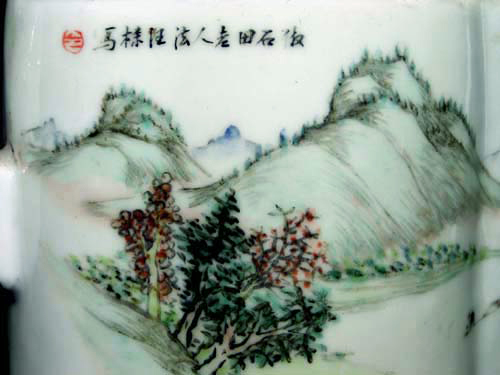 |
| Landscape using Yangcai by famous Qianjiang artist Wang You Tang. Technically the brush strokes are still good but the visual effect is less attractive compared with the 2nd photo by him executed using Qiangjiang cai. |
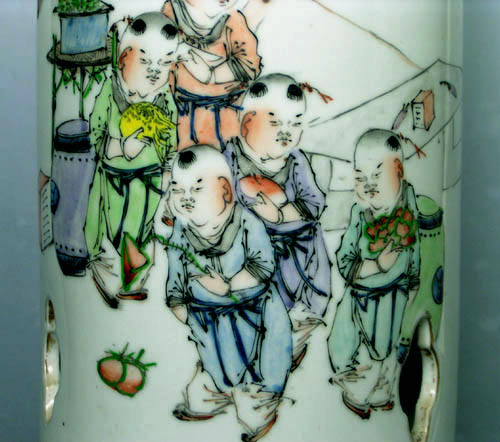 |
| An example with human subject using Yangcai |
As the style and composition of such Yang cai work is similar to fencai based Qianjiang painting, some collectors have difficulty differentiating them. Despite the shortcomings of Yangcai, there are still good standard works worth collecting. We should judge each by its individual artistic merits.

Republican period Pot decorated using Yangcai |
Plaque with landscape done in Yangcai |
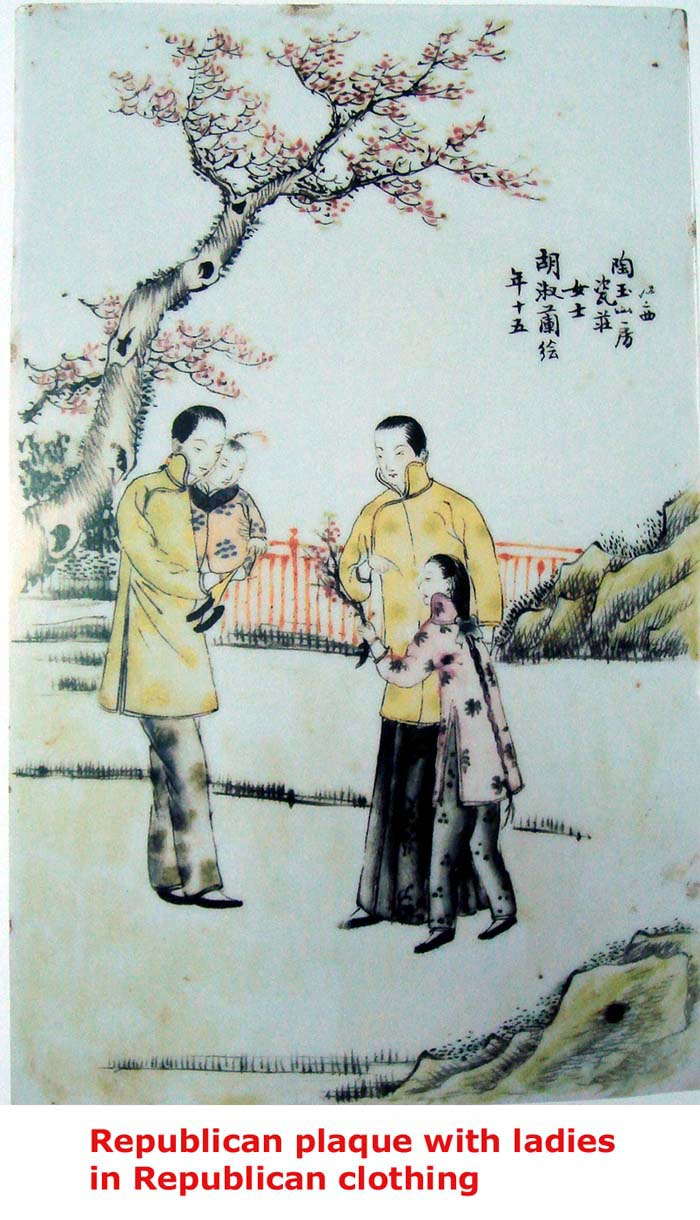 |
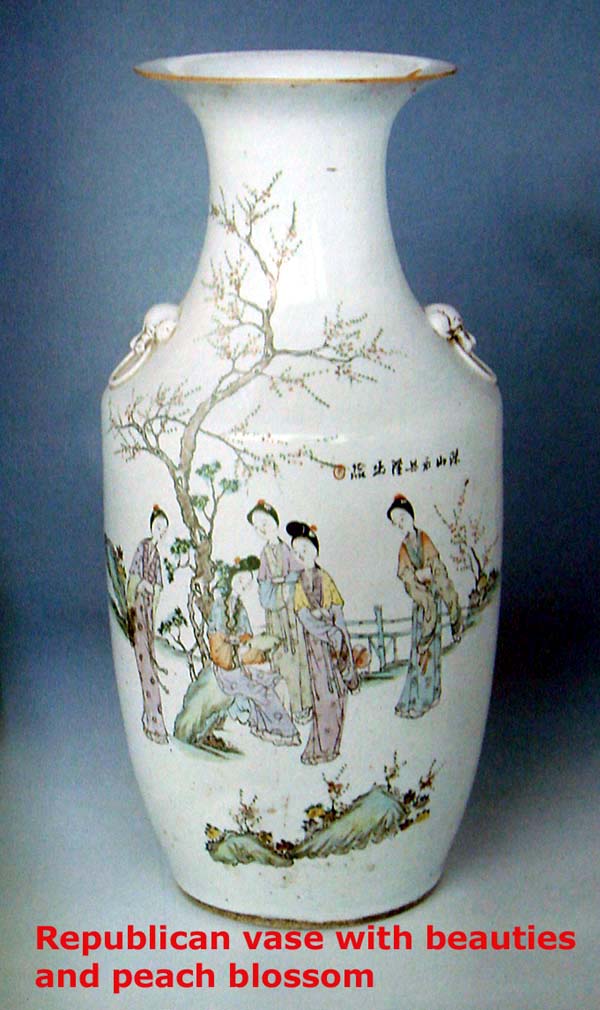
|
| Examples of popular Republican period motifs, left executed using Yangcai and right fencai | |
Introduction of New Fencai decorations
An important development during the Republican period was emergence of market for decorative art porcelains. They were produced by private workshops in Jingdezhen. The artists personally composed and executed the works. Their works were essentially a continuation of the literati style paintings on ceramics first popularised by the Qianjiang artists of the late Qing period. The Jingdezhen ceramics artists realised that Yangcai was a poor substitute for fencai based enamels for execution of their literati ink painting rooted tradition. After much experimentation, they found their answer in new fencai as the ideal medium. New fencai enamels are visually more vibrant especially with part of it decoration covered with a transparent glossy glaze. The artists' mastery of the improved fencai enamels were superb with ability to depict delicate fine shadings. The most famous pioneers of new fencai were Pan Taoyu and Wang Xiaotang. Pan was a all-rounder who was good in human figures, landscape and bird/flower. Wang was famous for his work on human figures. Both died young before the age of 40. Very few of their works survived.
Floral and birds by Pan Taoyu
Porcelain plaque by Wang Xiaotang
Among Pan Taoyu's students are Wang Yeting, Liu Yucen and Cheng Yiting, all members of the famous Eight Friends of Zhushan (珠山八友). The Eight Friends of Zhushan were among the best Fencai master artists of the Republican period. They were members of the Yue Yuanhui (月圆会), a society which members met on the full moon of every lunar month at Zhushan to interact and exchange ideas. Each of the artists specialised in a particular subjects and had their distinctive style. It is now generally accepted there were 10 artists who were at one point or another members of the society:
Wang Qi (王琦)- specialised in drawing of human figures. His earlier works was done more in the gong bi style , which is characterised by fine outline for the human figures. However, his style subsequently evolved into the more free and calligraphic style.
Wang Dafan (王大凡) - also specialised in drawing of human figures. He adopted the qong bi style for his human figures.
Deng Bishan (邓碧山)- specialised in fishes and reeds in style influenced by Japanese painting
Wang Yeting (汪野亭)- specialised in landscape
Tian Hexian (田鹤
Xu Zhongnan (徐仲南)- specialised in bamboo, rock and pine tree
Chen Yiting ting (程意亭)- specialised in birds and flower
Liu Yucen (刘雨岑)- specialised in birds and flower
He Xuren (何许人)(famous for his winter landscape)
Bi Botao (毕伯涛) (famous for birds and flowers)

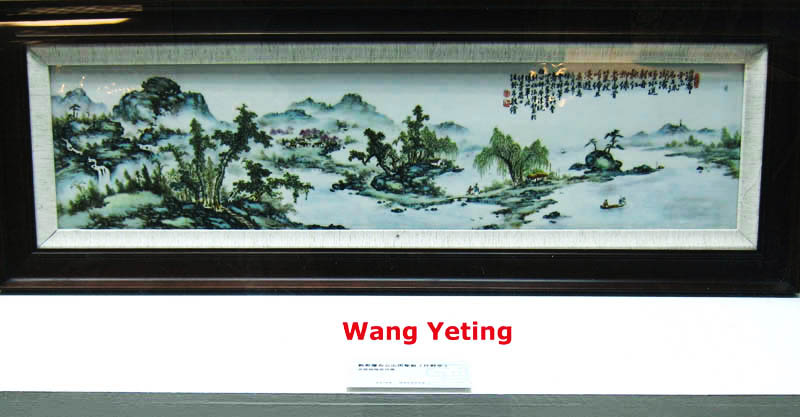

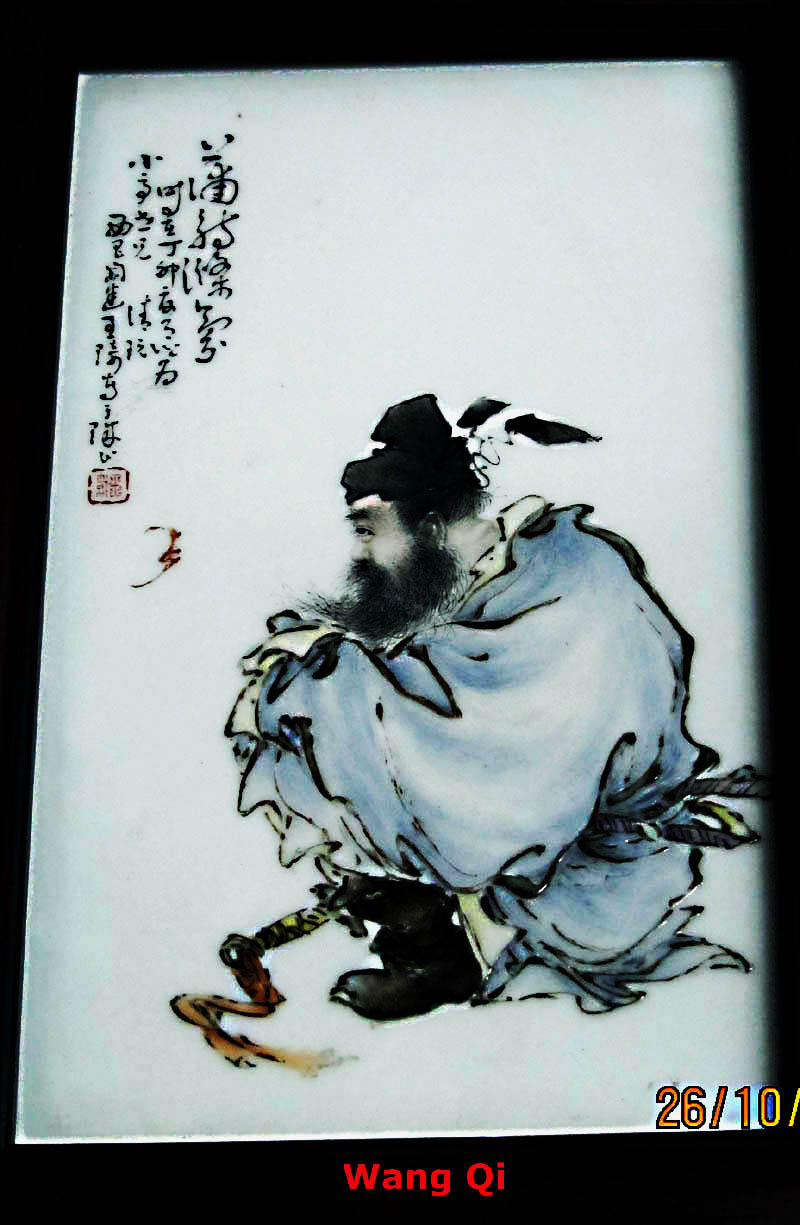
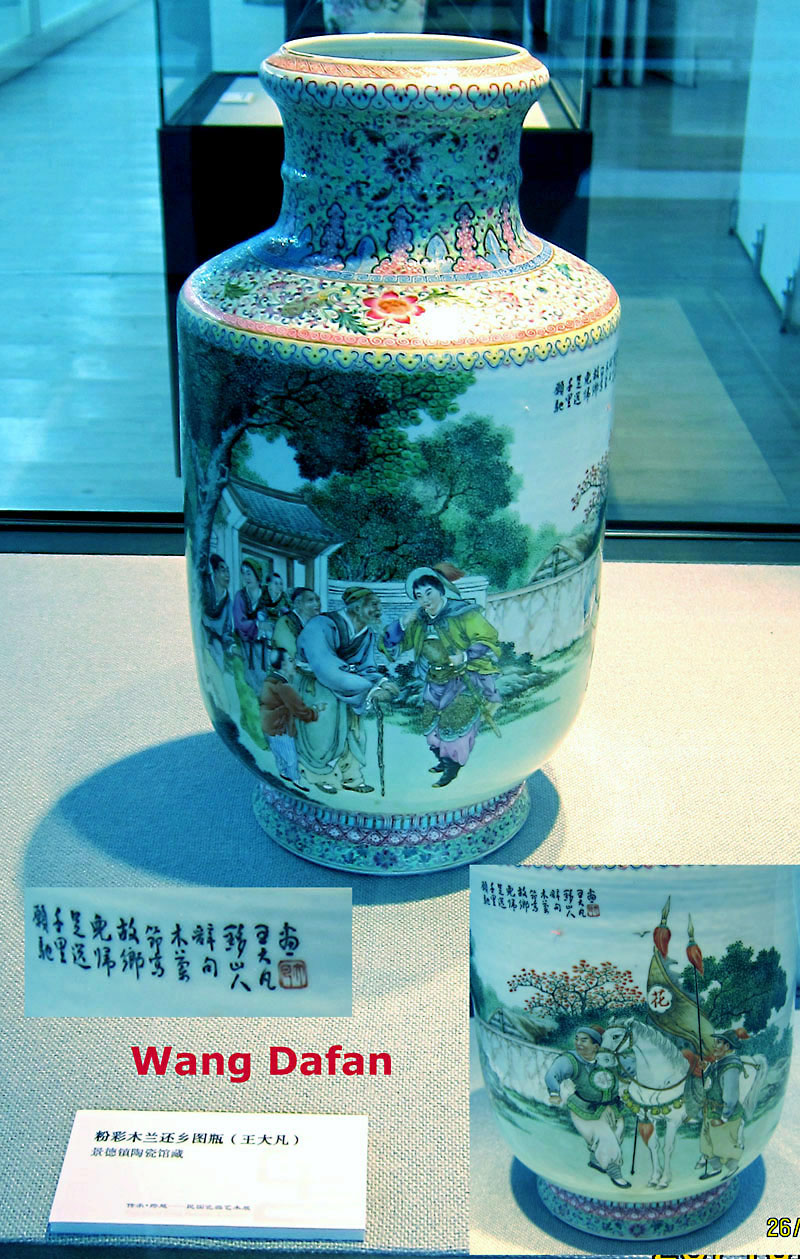
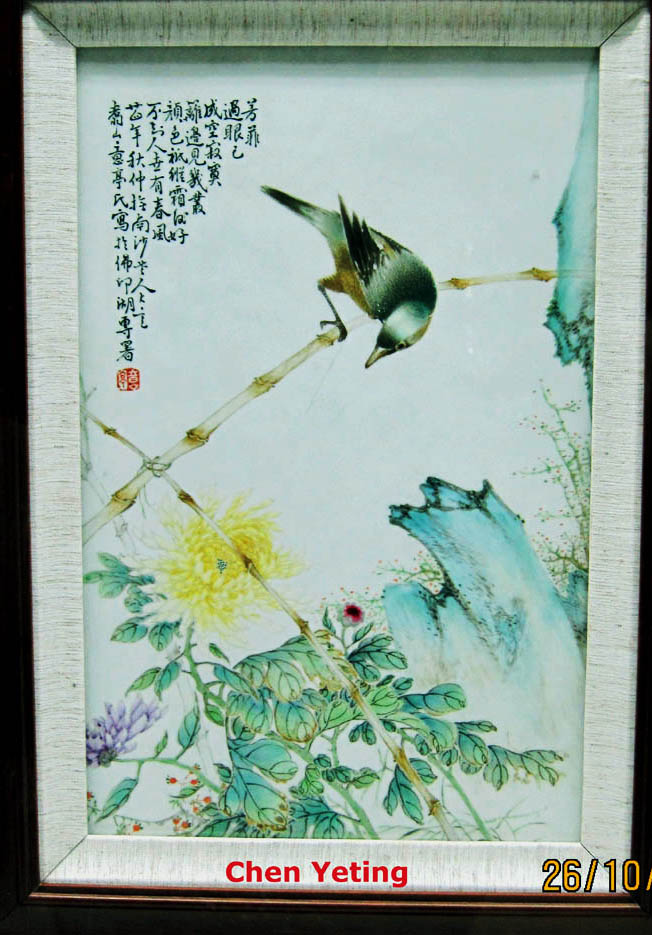

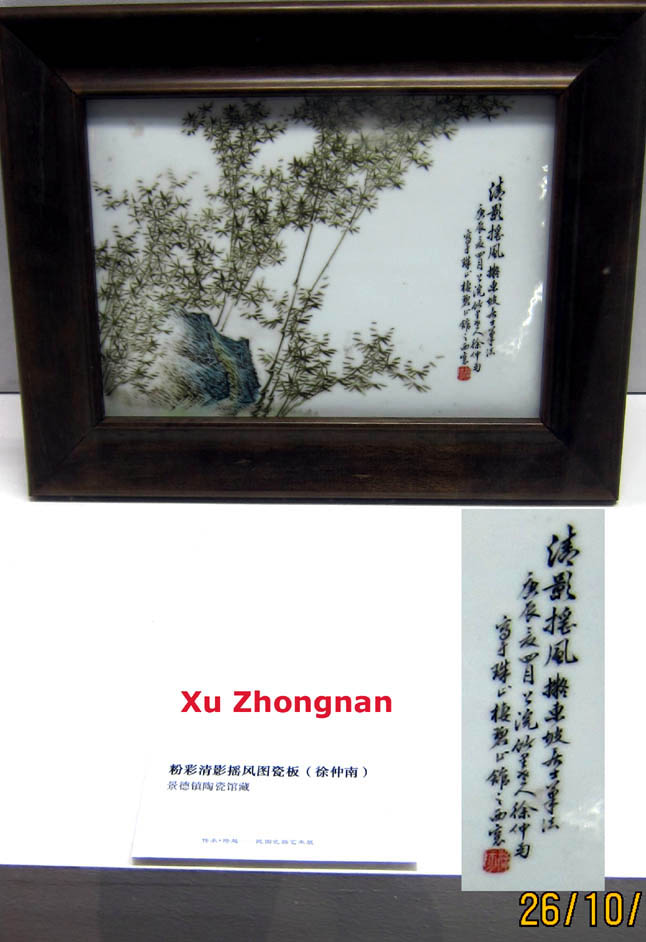
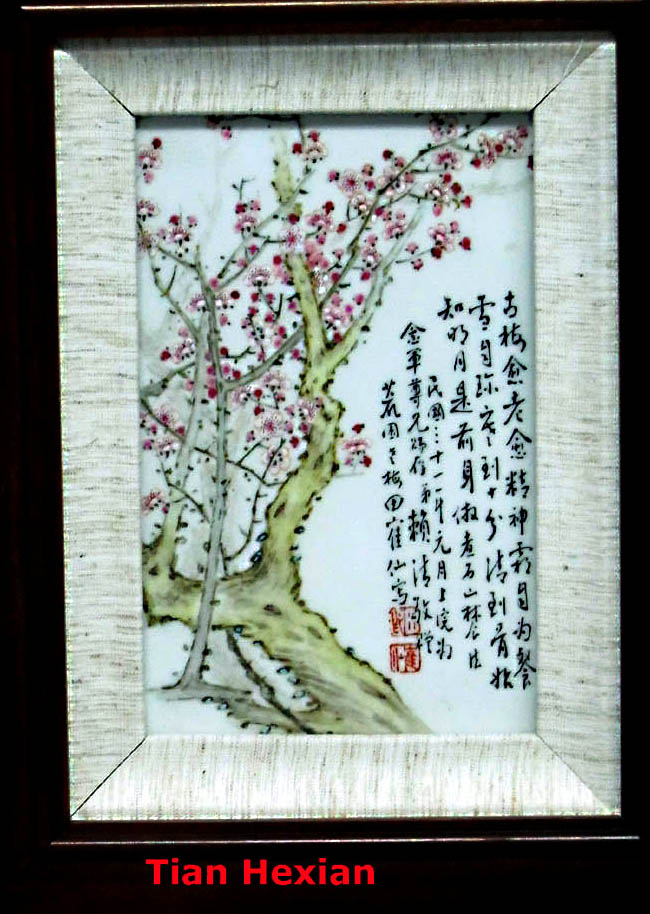
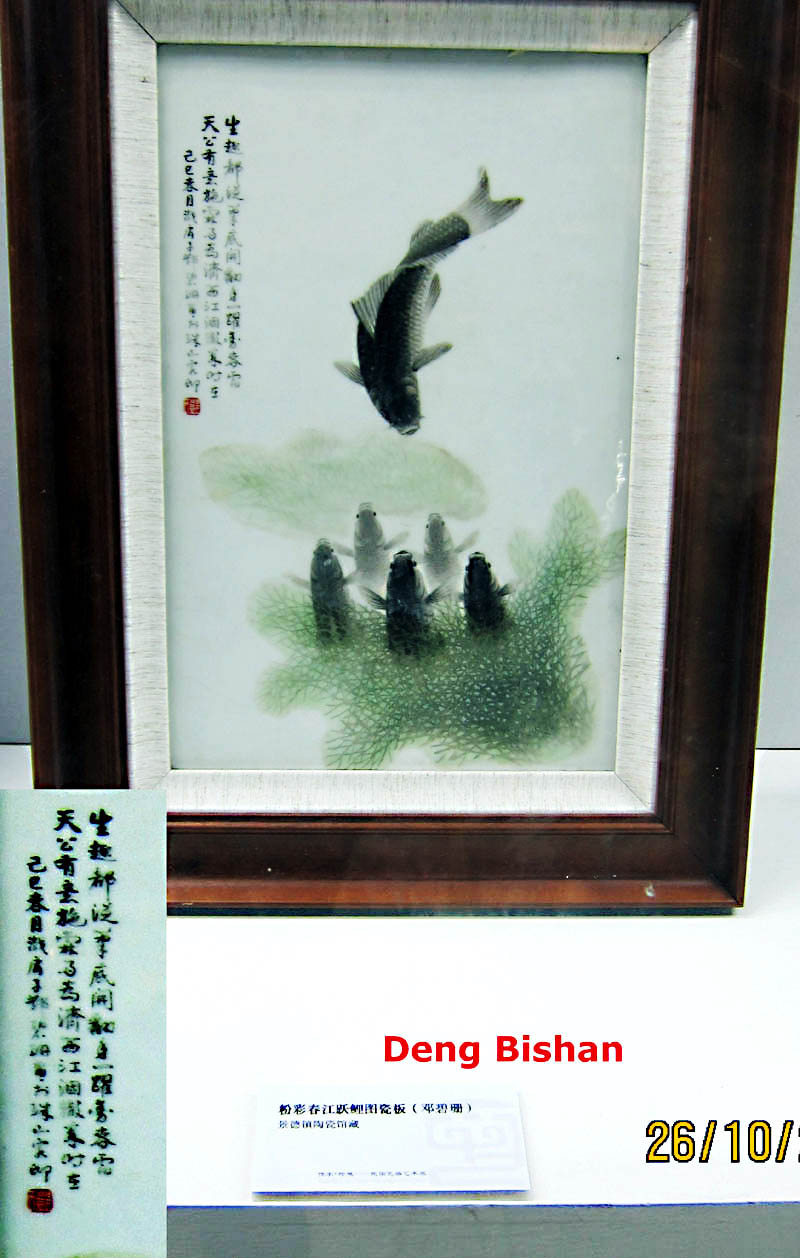
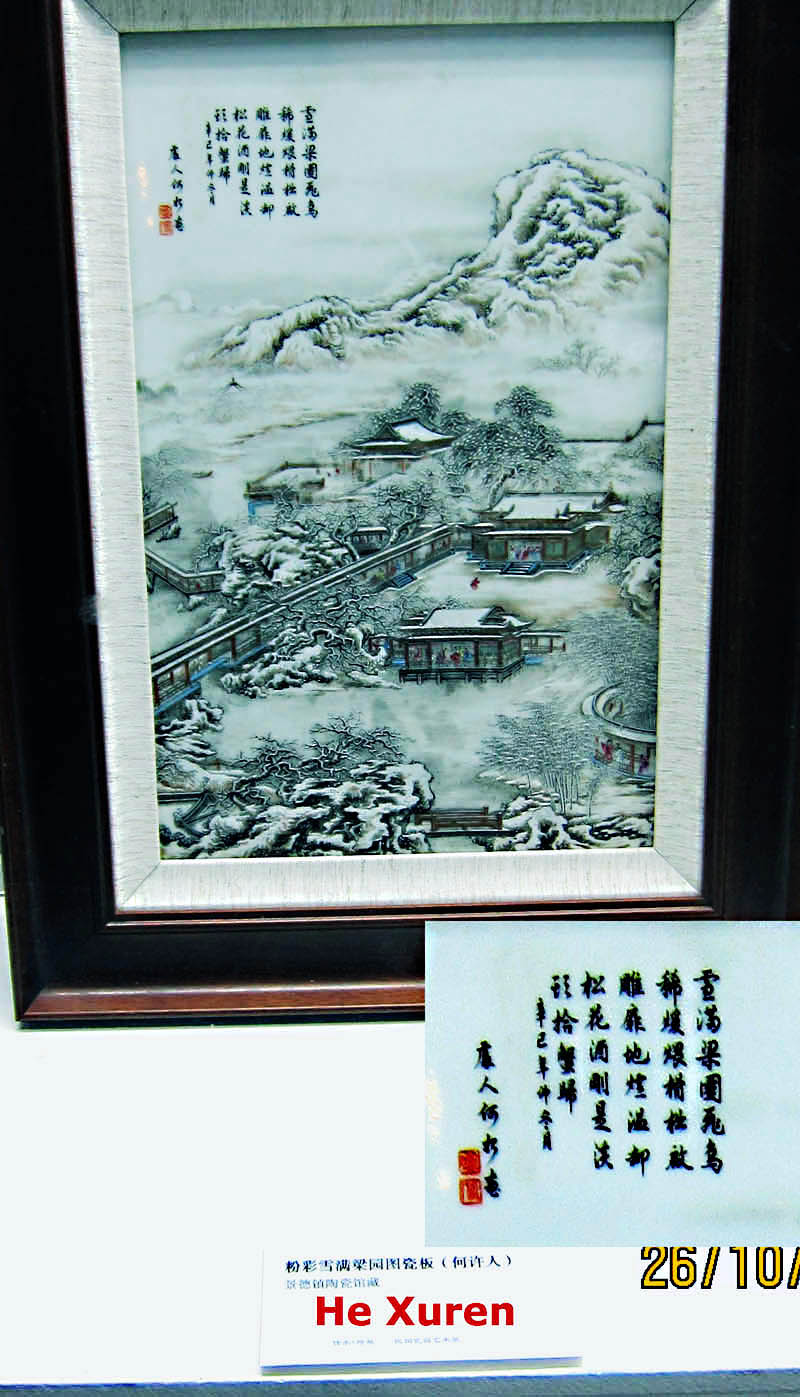
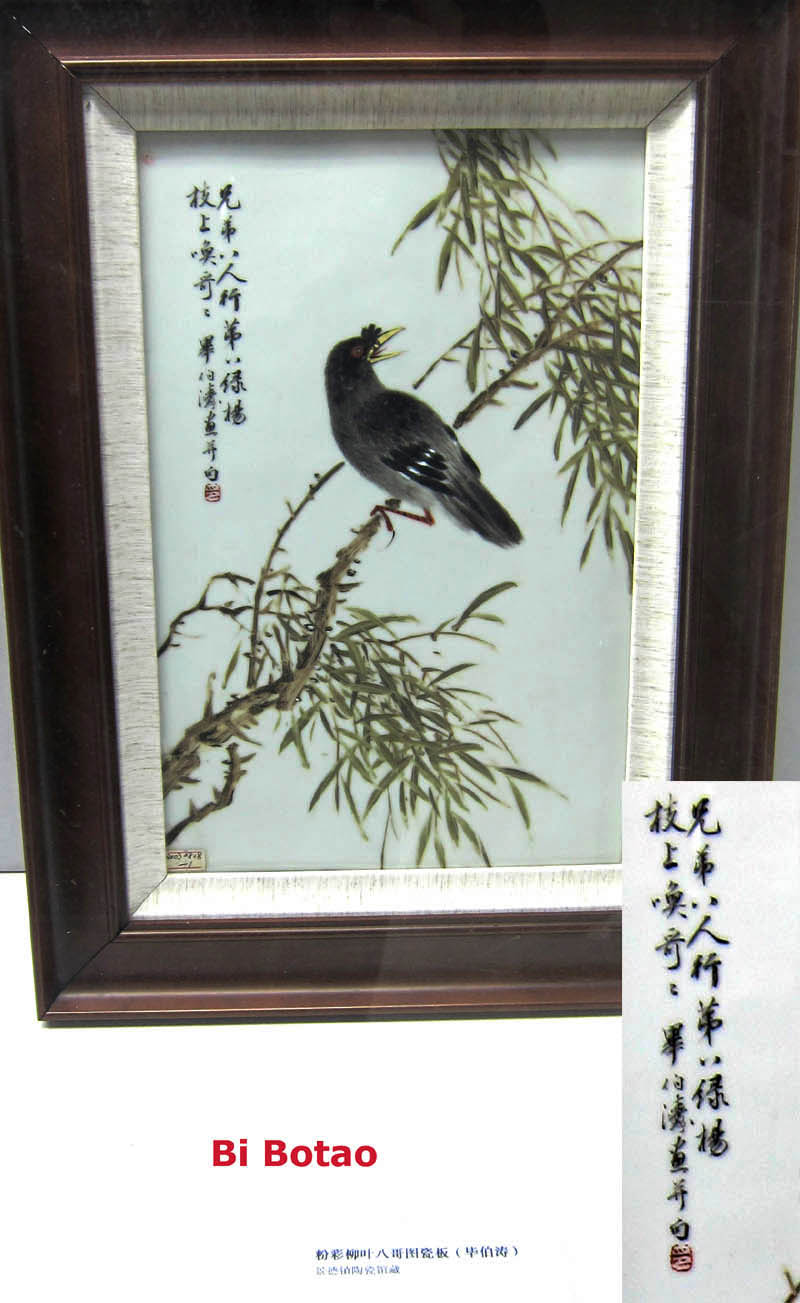
Some of the contemporaries of the Eight Friends of Zhushan, were equally good if not better. Among them are Wang Bu (王步) (famous for his blue and white), Wang Dacang (汪大沧)(famous for his landscape), Fang Yunfeng (方云峰)(famous for his human figures and cats) and Zhang Zhitang (张志汤) (famous for landscapes). This literati style of fencai painting was very successful and highly appreciated. They continued to be produced till today.

|
|
|
| Republican period porcelain plaques with new Fencai dcoration | |
Introduction of Shua hua (刷花)
This is a new decorative technique introduced during the Republican period. According to an article I came across, this technique was promoted in Jingdezhen by Feng Wan Bai(冯完白), a student from the Poyang Taoye school (鄱阳陶业学校). The famous Wang Ye Ting (汪野亭), one of the Zhushan 8 friends who is famous for his fencai landscape, also graduated from this school.
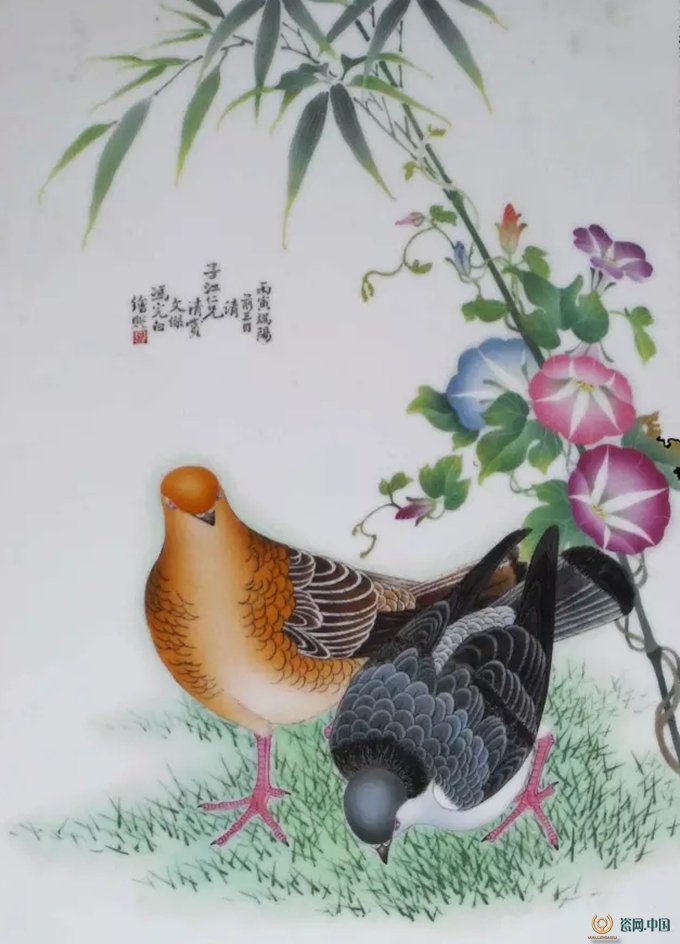
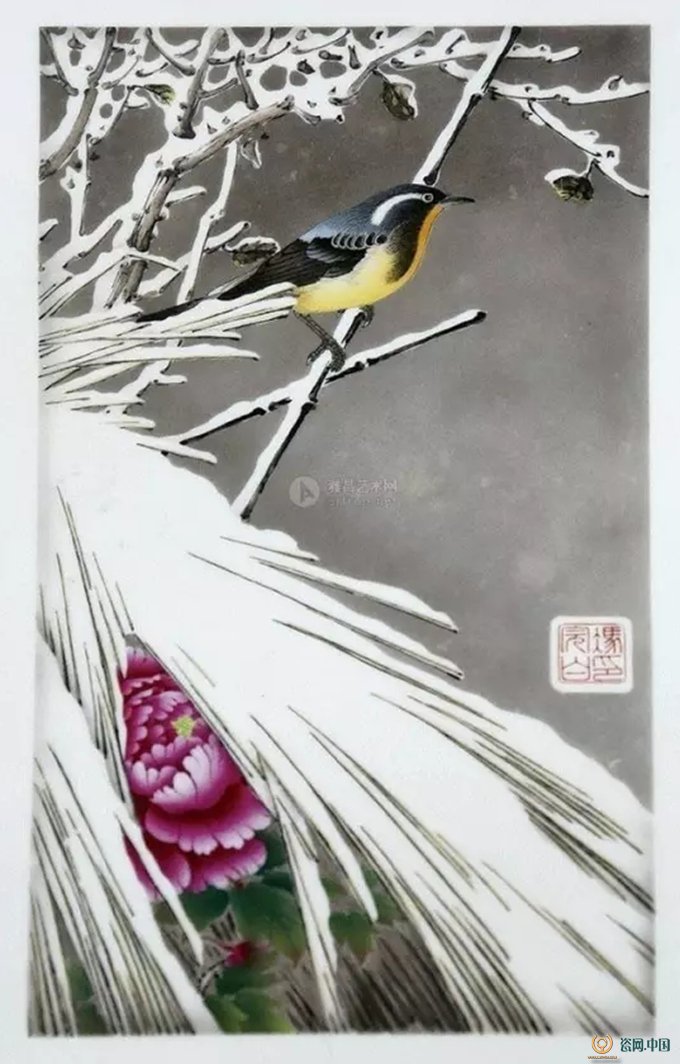
Two Shua hua works of Feng Wan Bai(冯完白)
This is a decorative technique which might have been inspired by the western air brush and traditional Chinese silk screen printing technique. A different set of implements were devised to apply the enamels. The effect which are typically more detailed and the colour layerings more subtle and refined as compared to that which can be achieved by air brush technique. It is a laborious process with successful work requiring good cutting and subtle colour application skill. A thin paper with pre-designed decoration is placed on the surface of the vessel, positioned firmly with glue. Once dry, a knife is used to cut progressively the outline of a specific section of the motif. Fine specks of the enamel are then applied through a sieve using a specially designed brush. The process is repeated for other sections of the motif. The term Shua hua literally means brushed decoration. If required, further details of the motif can bye added by painting or sometime using pointed tool, for example to delineate the veins of the leaves.
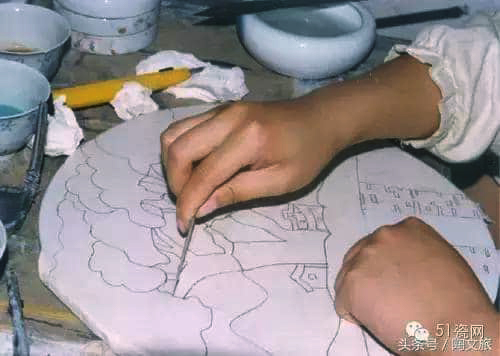
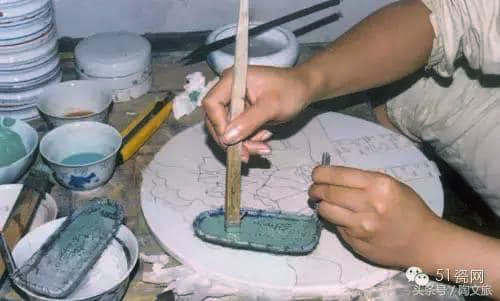
Shua Hua creation processes
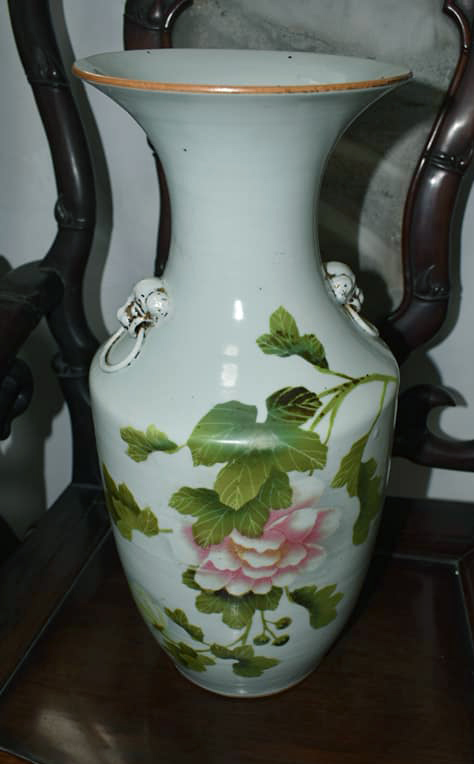
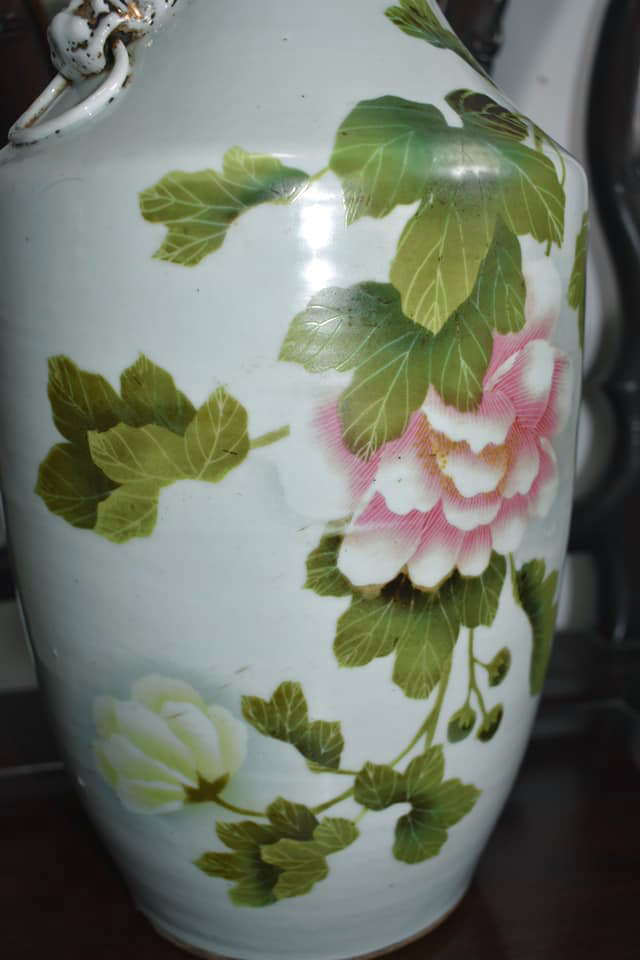
Republican period vase with Shua hua floral decoration
Shua hua for human subject is technically particularly challenging and attempted by very few practitioners of the art. The acknowledged master is Cheng Da You (程大有) whose works are much treasured. An example with good pictures of the fine details.
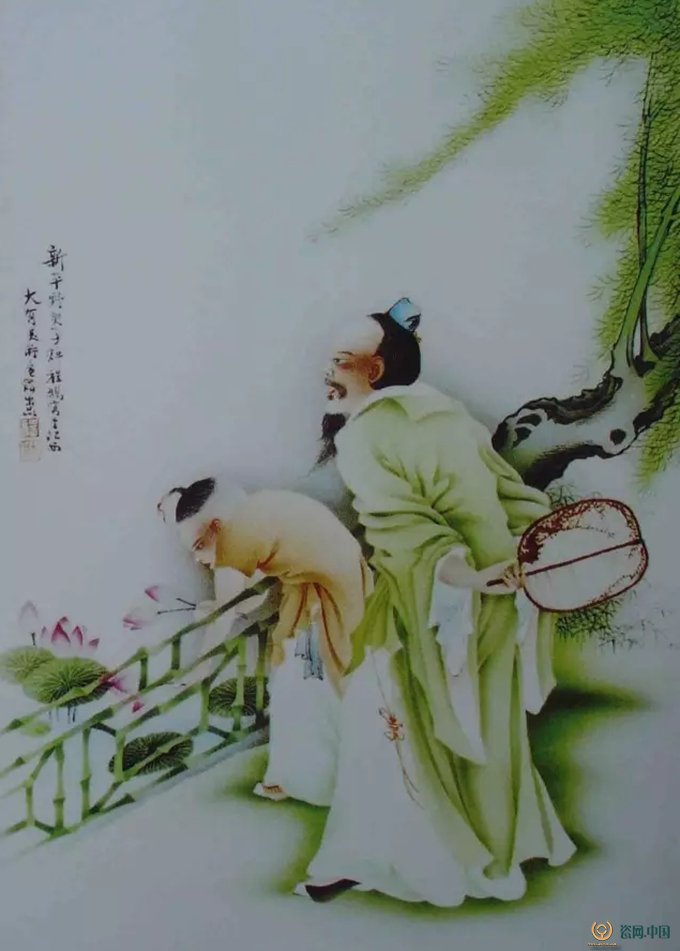
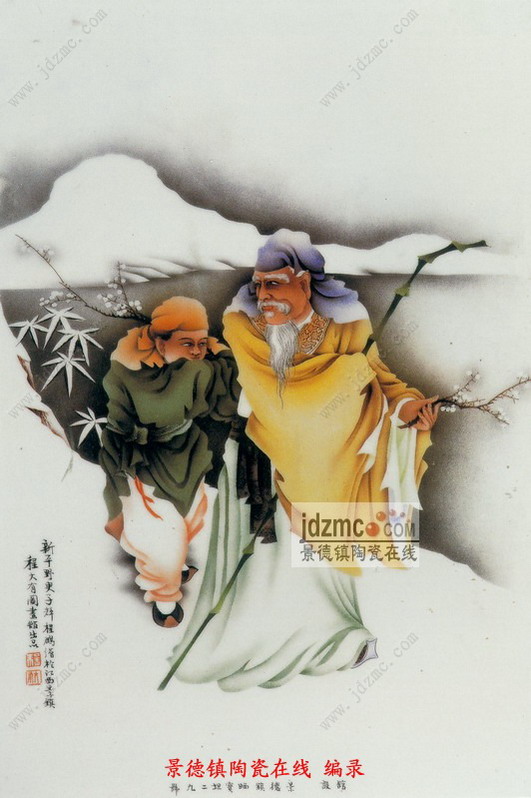
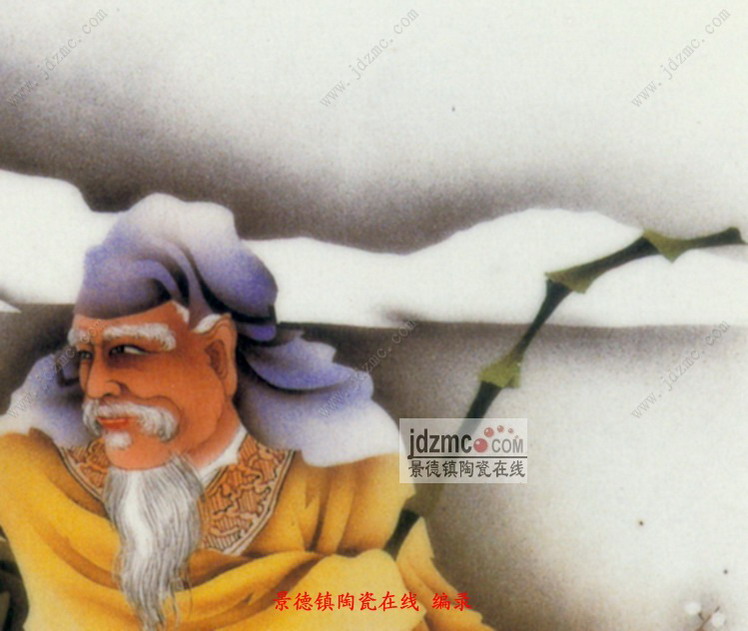
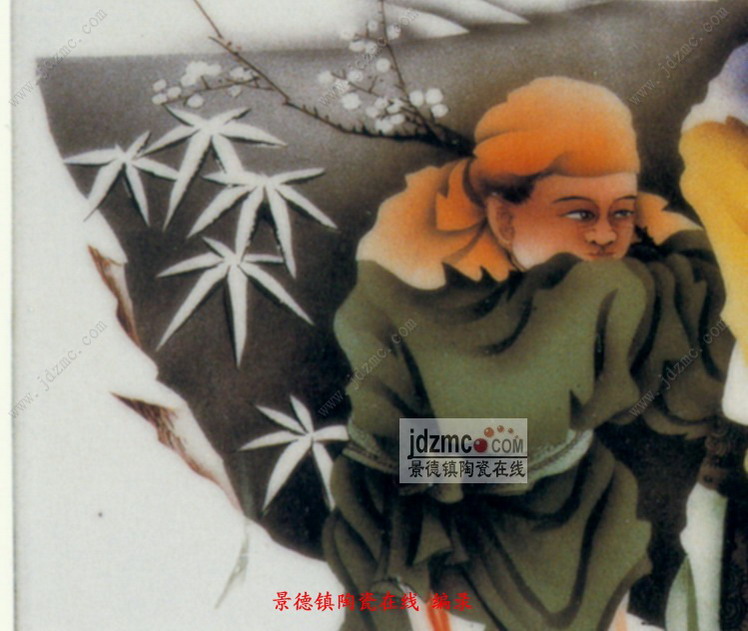
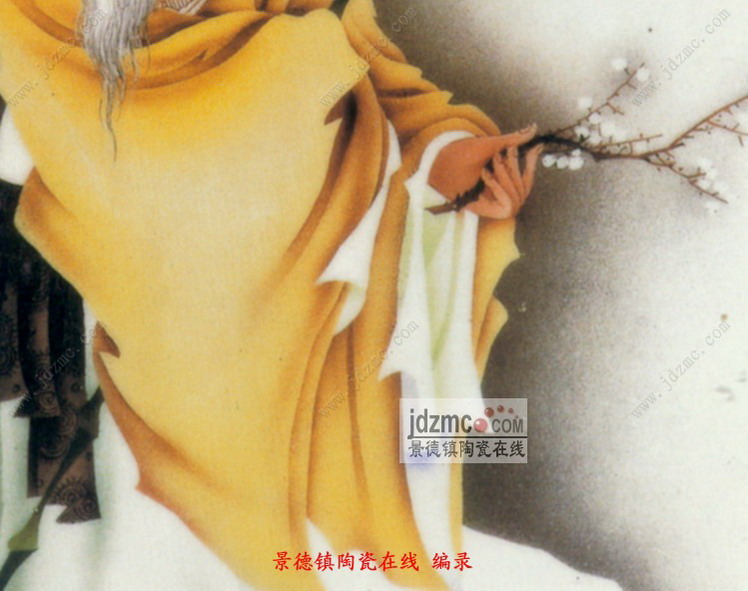
Shua hua works by Cheng Da You
Republican vogue for imitation of Qing Imperial wares
During the Republican period, there was also a vogue for imitation of Qing Imperial wares. The demise of the Qing dynasty resulted in the closure of the Imperial kiln. Many former craftsmen from the Imperial kiln were engaged to produce the copies. Especially popular were those overglaze polychrome wares that carried the Qianlong reign mark. Many were decorated in the falangcai style and they carried the Guyuexuan (古月轩) mark. There were also many with European subjects and with the Lang Shining mark (郎世寧). Some of the genuine falangcai pieces with European motifs made during the Qianlong period were said to be decorated by him. The imitations were highly demanded by the rich and high officials who were willing to pay exorbitant prices for them.
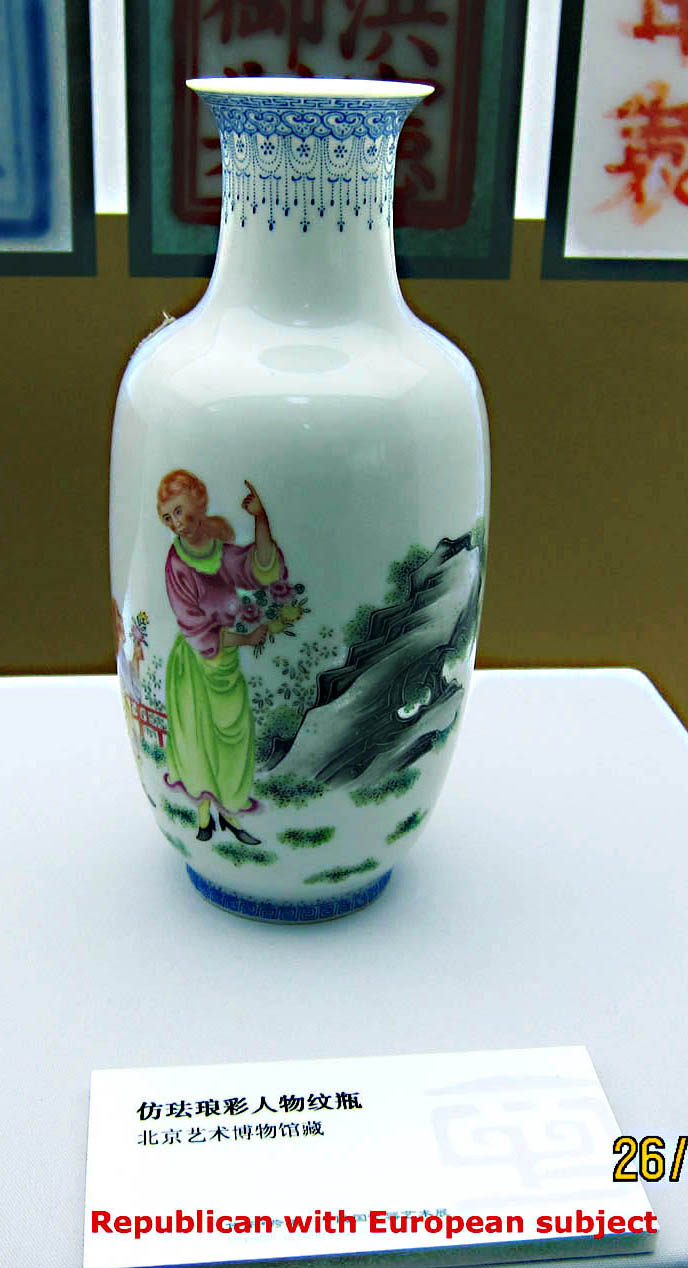
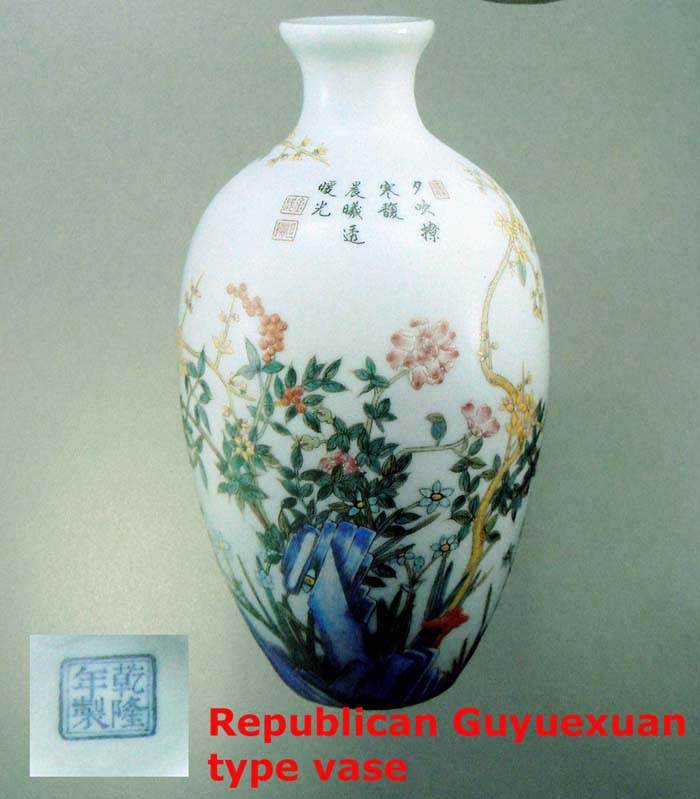
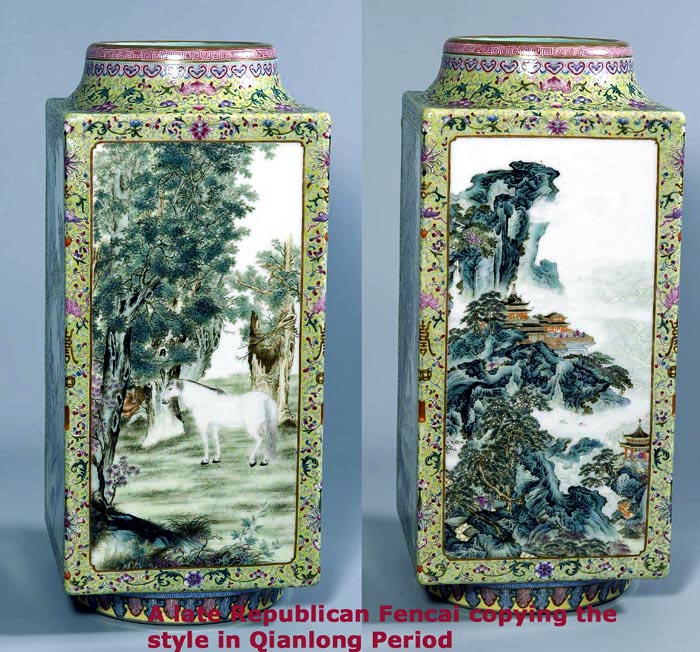
The Republican president Yuan Shikai (袁世凯) had also ordered Guo Baochang (郭葆昌) to supervise the making of porcelains for his personal use. They were modeled after the Qing imperial wares. It is now generally believed that the genuine ones carried the Jurengtang Zhi (居仁堂制) mark. Those that carried the Taowu Jiandu Guo Baochang Jingzhi (陶务监督郭葆昌谨制) marks were also believed to be among the porcelains made for Yuan shikai (please see below left photo). Those with the Zhizhai zhuren mark (觯斋主人) were produced for Guo's personal use. Those that carried the reign mark of Hongxian (洪宪) are now generally accepted as subsequent Republican copies. Nevertheless, many of the Hongxian marked pieces were of very good quality. Famous artists such as Wang Xiaotang and Wang Dacang were known to have painted some of the pieces. Indeed, the Republican period produced some of the best imitations of Qing imperial wares.


|
|
Vase with Hongxian Nianzhi mark |
Dish with the Hongxian Jiyuan (ie first year of Hongxian)
Written by: NK Koh (12 Apr 2010) Updated (26 Nov 2010), updated 17 Mar 2020
References:
1 Brush and Clay - Chinese Porcelain of the Early 20th Century